Mastering the Crosswind Landing Technique: Tips for Safer Touchdowns
Pilot's Life Blog
JUNE 18, 2025
Here’s a basic step-by-step approach we teach at Leopard Aviation: Approach Setup Begin by adjusting your heading slightly into the wind to maintain runway alignment. Maintain a stable approach speed, slightly above your normal landing speed, to help control the aircraft. What steps should I follow during a crosswind approach?














Let's personalize your content